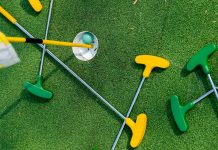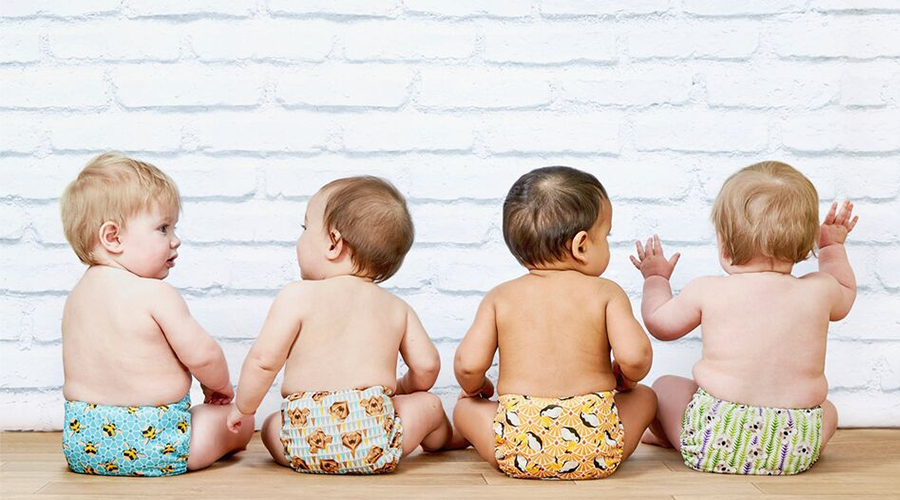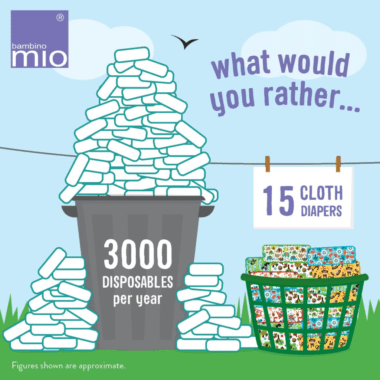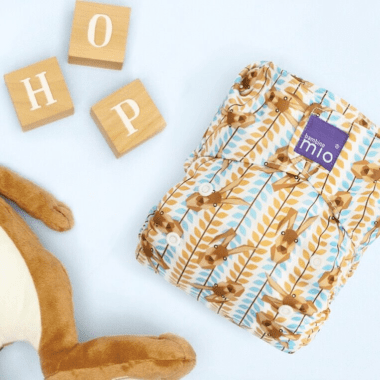Here’s a fact for you: the average baby will go through 3000 disposable diapers in one year. Think about that for a second.
Now, here’s another fact: the average baby will go through… wait for it… 15 cloth diapers in one year.
Amazing, right? If you consider just the cost of cloth versus disposable, it’s an obvious choice. But when you add in the environmental benefits, the arguments for using cloth become even more compelling. For example, did you know that it takes 500 years for a single disposable diaper to decompose and if every baby in the USA used disposables, that would mean 20 billion diapers per year?
And if the environmental argument doesn’t sway you, think about your baby. The diaper is the one article of ‘clothing’ that your child wears closest to their sensitive skin. Cloth diapers use absorbent fabrics rather than chemical gels to keep baby dry, eliminating a primary cause of recurrent diaper rash. How? The chemicals in disposables draw some of the moisture away, giving the impression that the diaper is soiled, when in fact it is. Thinking the diaper isn’t soiled, a baby will often be left longer between changes, which can result in diaper rash. A lot of children also experience diaper rash as a result of exposure to the chemical gels or scents in disposable diapers. So why not consider an alternative?
Are you new to cloth diapering?
Cloth diapers are easy to use, will save you money—even if you switch out your disposables for cloth only one or two times a day—and are made to be reused time and time again. If you’re having another baby at some point, cloth diapers can be passed down to the new arrival! After all, toddlers who wear cloth diapers typically potty train up to six months sooner than those who wear disposables!
Easy tips for using cloth diapers
Unlike cloth diapers in the past, today’s brands, like Bambino Mio, are compact, trendy and easy to use at home or out and about. They can fit from birth onwards, offering maximum protection and serious style! Many parents prefer cloth diapers in the case of those inevitable blow outs, as they do a better job of keeping everything contained. Cloth diapers can also be used overnight to keep baby dry and snuggled in super soft fabric.
How many cloth diapers you will need will depend on a couple of things:
- Are you using cloth full time or only part of the time? For example, some parents opt to use disposables when they are out and about and cloth at home. Interestingly, disposables don’t provide a unique advantage when out, as long as you’re prepared with a ‘wet bag’ to put the used diapers into until you get home.
- How often do you plan to launder the soiled diapers? You will need to make sure that you have enough to use while the rest are in the washing machine. You change cloth diapers as often as you would disposables—every 2 to 4 hours, so you can do your math based on that. Most newborns will go through 8 – 12 diapers in a 24 hour period, while kids 6 months and older will use fewer.
Addressing the question of leaks
Frequently asked questions for new cloth diaper users include leakage. Cloth diapers shouldn’t leak if they’re being used properly. If you’re experiencing leaks, ask yourself the following questions:
- Are you changing often enough? Every 2 to 4 hours should do the trick!
- Are you using a diaper liner? If you double it up or it isn’t laying flat in the diaper, you can experience some leaks.
- Are you using oil based rash creams? Oil based creams can reduce the absorbency of the diaper. Stick to a thin layer of water based diaper creams to avoid that: they’re better for baby’s skin anyway!
- Did you pre-wash your new diapers? This is mentioned in detail later, but for now, know that NOT pre-washing them before first use can have an impact on absorbency.
- Are the diapers fitting correctly? A cloth diaper should be snug against baby’s tummy and legs. Adjusting the angle of the velcro tabs has the best effect on the leg opening and keeping it tight!
- Do you simply need more absorbency? As baby grows, so do their bowel movements and quantities of urine, so you might get to a stage where the single layer diaper isn’t sufficient to absorb everything. At that point, all you need to do is add a layer with absorbent pads that can be added to a cloth diaper! And if you have never ‘strip washed’ your cloth diapers, it’s probably a good time to do this. Check the details on washing and drying, below!
Using cloth diapers when you’re not at home
As noted above, there’s no need to revert to disposables when you’re out on the town with your baby. The only difference is that you’ll pop the soiled cloth diaper into a wet bag that you will have pre-packed in the diaper bag, along with extra diapers. Then when you get home, all you have to do is drop those diapers into the dry/wet pail, ready for the washing machine.
Washing and drying cloth diapers
No need to rush to the washing machine every single day! Just store the soiled diaper—after disposing of any excess waste with a diaper liner or diaper sprayer in a dry/wet pail until you’re ready to wash, typically every 2-3 days. Ideally, you should line the pail with a mesh laundry bag so that all you have to do when it comes time to wash is pick up the whole bag and toss it in the washer! Easy as anything!
What kind of detergent is best? In the aim of avoiding too many chemicals, you should also make sure that your detergent is baby friendly, with no fragrance or added whiteners. Standard non-biological detergents often contain extra ingredients—enzymes—which can irritate baby’s sensitive skin, causing rashes or even an allergic reaction. Look for products instead that are designed for washing cloth diapers or at least for washing without harsh chemicals! No two detergents are alike to be sure to read the labels carefully!
Just be sure to keep the water temperature at around 104F. Too high temperatures and too frequent tumble drying will cause your diapers to wear out faster.
How should you dry your cloth diapers? For maximum sustainability and long wear, air drying is best to preserve them but tumble drying at a warm—not hot—temperature is fine too.
Getting stains out of cloth diapers? Stains are inevitable but there is a lot you can do to minimize and even eliminate them. Miofreshdiaper cleanser is designed specifically to prevent and reduce stains on cloth diapers. For particularly stubborn stains, a good soak in a solution of hand hot water and Miofresh can go a long way. But did you know that sunlight is nature’s stain remover? Putting the cloth diapers out to air dry in full sunlight is not just good to preserve them for a long time BUT it will also help to bleach stains away!
What is strip washing? A buildup of detergent and / or residual bacteria on cloth diapers can create an ammonia like odor and reduce the absorbency of the diaper, so if either of these are occurring, you should strip wash your cloth diapers to return them to optimal absorbency. If you get into the habit of doing this every four to five months, you’ll find that you have no issues with buildups. How do you strip wash diapers? Soak the diapers in hand hot water with an ounce of miofresh per 176 fl. Oz of water for two hours. Then wash them as usual and give them an extra rinse to make sure it’s all clean!
Got a new set of cloth diapers? Prewash before using them: they will become more absorbent after a few washes!
And make sure to skip the fabric softener for the diaper load. A lot of babies are sensitive to those products and they can affect the absorbency of a cloth diaper.
Babies, bank accounts and the environment would all be better off if everyone took a look at how easy it is to add cloth diapering to raising their little ones. Why not consider #choosingcloth today?
Cloth Diapering Made Easy
Better for your baby, your wallet and the environment!
Bio
Guy Schanschieff is the co-founder of Bambino Mio, the largest and most accessible diaper brand in the world, with distribution in 70 countries and over 50 awards to its name. The brand offers a range of cloth diapering products and accessories designed for the stylish, modern, and eco-conscious parent including the miosolo all-in-one diaper, miosoft two-piece diaper, reusable swim diapers, miosquares, potty training pants, and much more. Check them out online or on Facebook and Instagram
























